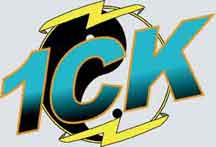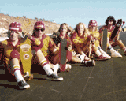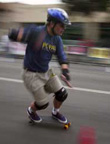Post
by Jack Smith » Sun Feb 03, 2008 2:55 am
Response to questions/concerns posted above:
In my opinion, the biggest issue with the proposal is not running both lanes and giving lane choice to one of the racers. Seldom is the racing surface without any crown. Seldom are the actual surfaces equal on both lanes. There are factors like grease, holes, surface/erosion inconsistencies, shading, plus inconsistencies in the actual cone placements.
In almost all events, one lane is simply a better lane to race on.
Slalom skateboard racing is seldom on a flat, consistent, surface like drag racing.
Seldom is heard a most discouraging word.
Thanks for pointing that out to me Chris, Even though I’ve organized over fifty dual slalom races, including five World Championships, I hadn’t given any thought to those factors. And evidently, the courses in drag racing are not all that consistent, if they were, perhaps they would just flip a coin for lane choice.
This new format will definitely put more pressure on the organizer to find venues where as identical as possible courses can be set.
Somewhere close to 100% of the ISSA sanctioned races were sanctioned according the ISSA sanctioning guidelines....
Maybe you were trying to make some other point?
Any update on this Pat?
I really like this idea...for the most part. I have to agree with Cbark that it would seem unfair to make some people race one course and others race another, possibly slower, course...is there a way to work it so we race two runs (one on each course), or does that put us right back where we are now? I guess, with a double elimination format, it would take too much time?
In a perfect world, where we had unlimited time on the hill, or very few racers, I would
love to use the “double elimination” and the one run in each lane system.
1) Distance- who is going to make sure that each course is exactly the same length? Not only linear, but also in relation to the path througth the cones?
A tape measure, GPS or measuring wheel can assure courses of the same length. As for path through the cones, very racer’s path is different.
Drag racers know that each lane is precisely 1/4 of a mile long.
Slalom course setters do their BEST, and I respect ALL their efforts, to make sure both lanes are somewhat equal, but I doubt that each lane is exactly the same length or has the exact degree of difficulty. We can't expect race organizers to have all their races on straight pieces of pavement, or spend more time setting up courses to ensure that each of their race courses are exactly the same
I don't think any rider would want to go into any elimination round knowing that their lane has been consistantly .3 to .8 seconds slower all day long, because it is either a longer course or more difficult.
Well Art, I agree with you here. Solution; qualify as fast you can.
2) Real-time information- In order for any racer to make at least a semi-intelligent decision as to which lane to choose we must have real-time information.
We must know, before the elimination rounds begin, which lane has been faster and had the least number of cones hit. This means there must be, as I'm sure there is in drag racing, computer printouts of detailed results for every racer throughout the qualifying rounds, and these results must be posted in an area where ALL racers can view/study them before the elimination rounds begin.
After the practice round and qualifying, I think most racers should have a good idea what course is faster. But I must say, that I’ve been to numerous races over the last seven years, where the biggest topic of discussion throughout the day is “which lane is faster”.
In my experience the verdict is usually split right down the middle.
As for Q-times being available to “study”, I think most race organizers doing a pretty good job in this area.
The only negative, and I hestitate to mention as I fully support trying this out, is the death of the clean run. I enjoy doing a clean run, I enjoy watching a clean run, and i think it's inpressive for spectators to watch two racers neck and neck, clean and clean. This new system incents me to hit some cones.
Now Joe, why would you want to hit a cone. How may times do you need to be told “cones are your friends”. Spectators will still love and applaud clean runs.
Doesn't this new system allow a person of greater skill to sandbag to the loser brackets? This person(s) could work their way past the lycra clothed, the beer belly enhanced and those who wear shirts to hide our man-boobs...eventually reaching the top.
Regardless if you can ever stop sandbagging..change is good and again it should be another awesome year..for the kids who kill on the slalom course.
Never understood the sandbagging deal. In the “double elimination” system, racers from the “winner’s bracket” will be joining the “do or die” bracket throughout the competition, so a racer would have no idea who he might meet in the latter rounds of the “do or die” bracket.
I just wanted to add one more thing. If one were to take a quick look at the pro's final 8 to finish PDF results from some of the top races in the US, and maybe Europe, over the past year or so you'll notice that generally one lane was faster than the other.
Same answer as above, qualify faster.
I was wondering, if you decide to have the top qualifiers choose lanes, what will be the time frame for them to make this decision? There may be some that like to play mind games and say they want the "white course", and then just before their run starts "change" their mind and choose the "red course" that they wanted all along.
Good question Art. How about, once the racer steps onto the start platform, he cannot change his mind.

















